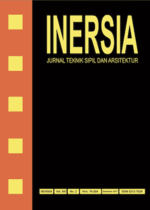PENGARUH DESAIN COURTYARD TERHADAP KONSUMSI ENERGI UNTUK AC (AIR CONDITIONER) DAN PENCAHAYAAN (Studi Simulasi Hipotetik Bangunan Tinggi Perkantoran di Jakarta)
DOI:
https://doi.org/10.21831/inersia.v14i1.19493Abstract
ABSTRACTIncreasing the natural lighting can reduce the lighting energy consumption haw a weather but it can be potentially increasing the weather energy so there must be strategy needed to save the energy. That condition is the problem statement of this research, to know the configuration of the natural lighting and the effective cooling load. In this research, the simulation method with hypothetic building object has been used to test how big the influence of courtyard dimension, (Wall To Window Ratio) WWR and glass type towards the total consumption of energy for AC (Air Conditioner) and lighting. The result of this research is the most affective courtyard configuration is courtyard dimension 1, WWR 30 %, stopsol glass type. From the courtyard dimension variable, WWR and glass type, for the total energy consumption for AC and the highest lighting influenced its energy efficiency is clear glass type 15,56%, panashap glass 9,09%, WWR 70% 6,25%, WWR 50% 1,91%, courtyard dimension 2 0,27%, courtyard dimension 3 0,18%. In Jakarta with the tropical climate is not suitable to apply the courtyard application which is too big, it must be concerned the wide and high proposition so the total energy consumption for AC and lighting would not be so big. While the open orientation is not so influencing the sun radiation, so avoid the open part from east and west. For the WWR building range is between 50% - 70% must be paid attention in choosing the glass type because as small as the SC (Shading Coefficient) is lower the sun radiation.
Keywords : AC (Air Conditioner), Courtyard, Glass type, Lighting, WWR. ABSTRAK
Meningkatkan pencahayaan alami dapat mengurangi konsumsi energi pencahayaan namun, berpotensi meningkatkan energi penghawaan maka diperlukan strategi untuk penghematan energi. Kondisi tersebut yang menjadi permasalahan dalam kajian ini, untuk mengetahui konfigurasi pencahayaan alami dan beban pendinginan yang efektif. Dalam kajian ini digunakan metode simulasi dengan objek bangunan hipotetik untuk menguji besar pengaruh dimensi courtyard, (Wall To Window Ratio) WWR dan Jenis kaca terhadap total konsumsi energi untuk AC (air conditioner) dan pencahayaan. Hasil dari kajian ini adalah konfigurasi courtyard yang paling efektif yaitu dimensi courtyard 1, WWR 30%, jenis kaca stopsol. Dari variabel dimensi courtyard, WWR dan jenis kaca, untuk total konsumsi energi untuk AC dan pencahayaan yang paling tinggi berpengaruh dalam efesiensi energinya adalah jenis kaca clear 15.56%, kaca panashap 9.09%, WWR 70% 6,25%, WWR 50% 1,91%, dimensi courtyard 2 0.27%, dimensi courtyard 3 0.18%. Pada kota Jakarta dengan kondisi iklim tropis kurang cocok untuk pengaplikasian courtyard yang terlalu besar, harus di perhatikan proporsi lebar dan tinggi courtyard agar total konsumsi energi untuk AC dan pencahayaan tidak terlalu besar. Sedangkan orientasi bukaan sangat berpengaruh terhadap radiasi matahari, sehingga hindari bukaan dari arah timur dan barat. Untuk range WWR bangunan antara 50 -70% perlu di perhatikan dalam memilih jenis kaca karena semakin kecil SC (Shading Coefficient) maka semakin rendah radiasi matahari.
Kata kunci: AC (Air Conditioner), Courtyard, Jenis kaca, Pencahayaan, WWR.
Downloads
Published
How to Cite
Issue
Section
License
Authors who publish with INERSIA journal agree to the following terms:
- Authors retain copyright and grant the INERSIA journal right of first publication with the work simultaneously licensed under Creative Commons Attribution License (CC BY 4.0) that allows others to share the work with an acknowledgment of the work's authorship and initial publication in this journal.
- Authors can enter into separate, additional contractual arrangements for the non-exclusive distribution of the published version of the work (e.g., post it to an institutional repository or edit it in a book), with an acknowledgment of its initial publication in this journal.
- Authors are permitted and encouraged to post their work online (e.g., in institutional repositories or on their website) before and during the submission process, as it can lead to productive exchanges, as well as earlier and greater citation of published work.

INERSIA by https://journal.uny.ac.id/index.php/inersia was distributed under a Creative Commons Attribution 4.0 International License







